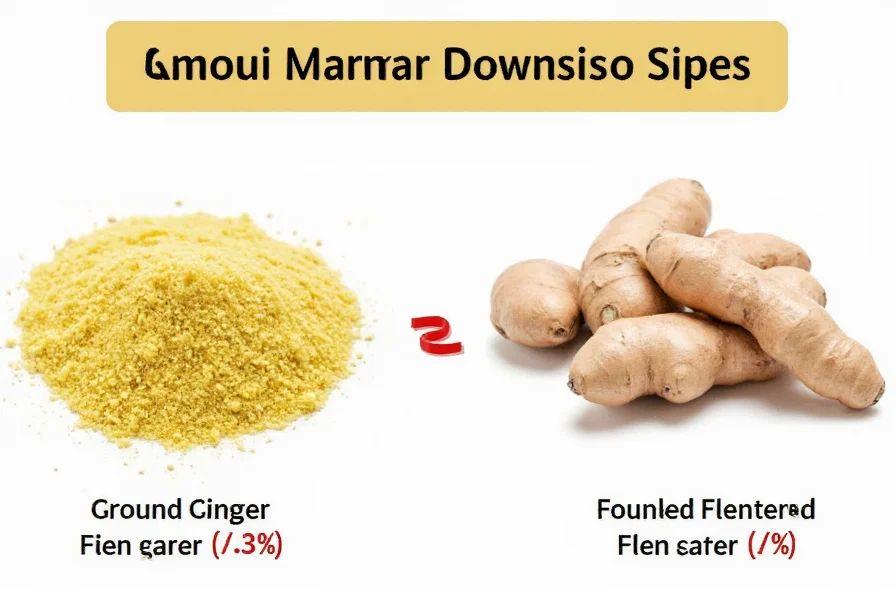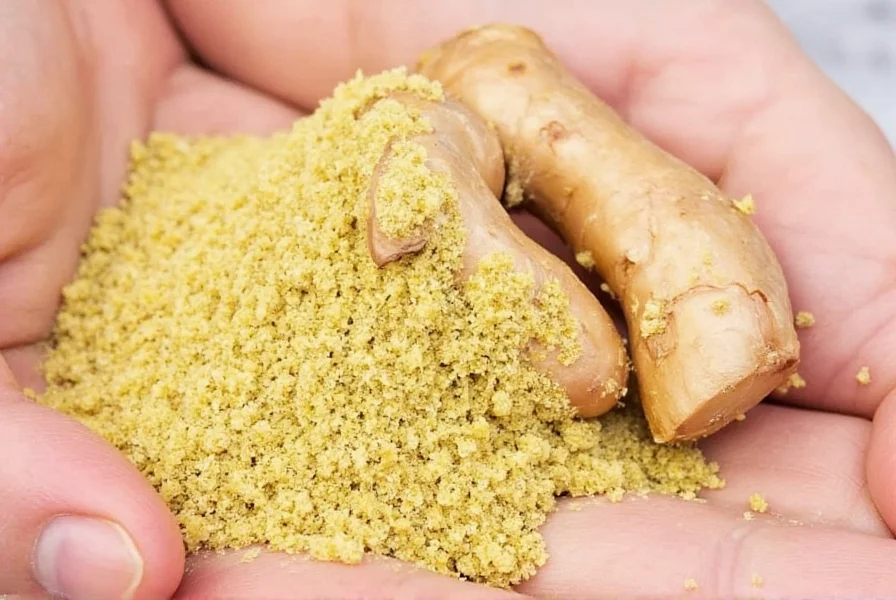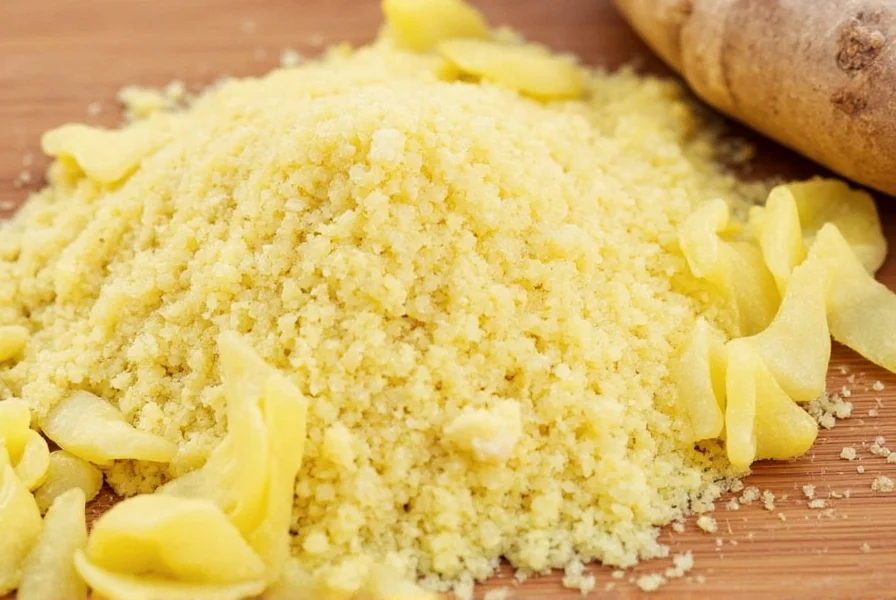The standard ground ginger to fresh ginger ratio is 1:3—meaning 1/4 teaspoon of ground ginger equals 1 tablespoon of freshly grated ginger. This conversion accounts for the concentrated flavor of dried ginger powder compared to the milder, juicier fresh root. However, the ideal ratio varies by recipe type, ginger freshness, and personal taste preferences.
When substituting between fresh and ground ginger, understanding the flavor intensity difference is crucial for recipe success. Fresh ginger contains more moisture and has a brighter, sharper flavor profile, while ground ginger offers a more concentrated, slightly sweeter, and warmer taste due to the drying process. This fundamental difference explains why direct 1:1 substitutions often lead to disappointing results.
Chefs and home cooks frequently face the challenge of converting between these two forms of ginger, especially when a recipe calls for one form but only the other is available. The conversion isn't merely mathematical—it requires understanding how ginger's chemical composition changes during the drying process. When ginger is dried and ground, its volatile oils concentrate while moisture evaporates, intensifying certain flavor compounds while diminishing others.
| Ginger Form | Equivalent Measurement | Best For |
|---|---|---|
| 1 tbsp fresh grated ginger | 1/4 tsp ground ginger | Asian cuisine, marinades, beverages |
| 1 tbsp fresh grated ginger | 1/2 tsp ground ginger | Baking, spice blends, long-cooked dishes |
| 1 tsp ground ginger | 1 tbsp fresh grated ginger | When reducing intensity in finished dishes |
The standard ground ginger to fresh ginger conversion ratio serves as a starting point, but experienced cooks know that adjustments are often necessary. For delicate dishes like seafood or light sauces, use the lower end of the ratio (1/4 teaspoon ground ginger per tablespoon fresh). In robust recipes like curries, stews, or baked goods where ginger plays a supporting role, you might increase to 1/3 or even 1/2 teaspoon of ground ginger per tablespoon of fresh.
Several factors influence the ideal ground ginger to fresh ratio in your specific application:
Recipe Type Considerations
The cooking method significantly impacts substitution effectiveness. In raw applications like salad dressings or fresh salsas, fresh ginger's bright flavor shines, making ground ginger a poor substitute. For these cases, consider using a smaller amount of ground ginger (about 1/8 teaspoon per tablespoon fresh) or adding a squeeze of lemon to mimic freshness. In contrast, baked goods and long-simmered dishes benefit from ground ginger's concentrated flavor, where the higher ratio (up to 1/2 teaspoon per tablespoon) often works better.
Ginger Freshness Factor
The age of your fresh ginger dramatically affects potency. Young, moist ginger from the produce section has a milder flavor than older, fibrous roots. If using exceptionally fresh, plump ginger, you might need slightly more ground ginger to achieve equivalent flavor. Conversely, if your fresh ginger is starting to dry out, reduce the ground ginger amount. This variability explains why many professional chefs recommend tasting as you go when substituting between forms.

Flavor Profile Differences
Understanding the chemical changes during drying helps explain why substitution isn't straightforward. Fresh ginger contains gingerol, which provides its characteristic sharpness. When dried, gingerol converts to zingerone and shogaol—compounds with warmer, sweeter notes. This transformation means ground ginger lacks the bright, citrusy notes of fresh ginger but offers deeper, more complex warmth. For recipes where ginger is a featured ingredient (like ginger tea or ginger candies), consider supplementing ground ginger with a pinch of lemon zest or a dash of fresh citrus juice to recapture some freshness.
Storage and Shelf Life Implications
The ground ginger to fresh ratio also relates to practical kitchen considerations. Fresh ginger lasts 2-3 weeks refrigerated (or months frozen), while ground ginger maintains peak flavor for 6-12 months in a cool, dark place. When your fresh ginger supply runs out, knowing the proper conversion ratio prevents recipe failures. Many professional kitchens keep both forms on hand specifically because they serve different culinary purposes—fresh for brightness, ground for depth.
Common Substitution Mistakes
Cooks often make two critical errors when converting between ginger forms: using equal volumes (1:1 ratio) or failing to adjust for recipe moisture content. Since ground ginger lacks the water content of fresh (about 80% water), adding it to recipes designed for fresh ginger can sometimes dry out the final product. In baking applications, compensate by adding 1-2 teaspoons of liquid per substitution. Conversely, when replacing ground ginger with fresh in spice blends, account for the extra moisture by slightly reducing other liquids.

Professional Chef Recommendations
Top chefs suggest these practical guidelines for ground ginger to fresh conversion:
- For most savory applications: Start with 1/4 teaspoon ground ginger per tablespoon fresh, then adjust to taste
- For baking: Use 1/3 to 1/2 teaspoon ground ginger per tablespoon fresh
- For beverages: Use 1/8 to 1/4 teaspoon ground ginger per tablespoon fresh
- When reducing recipe size: Maintain the same ratio but decrease total amount
Remember that personal preference plays a significant role—some palates detect ginger's heat more intensely than others. Always add ground ginger gradually, allowing 5-10 minutes for flavors to develop before adding more. This patience prevents the common mistake of over-spicing, which cannot be corrected once incorporated.
When Substitution Isn't Advisable
While the ground ginger to fresh ratio works for many applications, certain dishes simply require one form over the other. Fresh ginger's fibrous texture provides desirable mouthfeel in stir-fries and salads that ground ginger cannot replicate. Conversely, ground ginger's even distribution makes it superior for spice rubs and baked goods where texture consistency matters. Recognizing these limitations helps determine when to seek alternative solutions rather than force a substitution.
Creating Your Own Conversion Guide
For frequent substitutions, create a personalized reference based on your taste preferences and common recipes. Track your adjustments in a kitchen notebook—note when you used 1/4 versus 1/3 teaspoon of ground ginger per tablespoon of fresh, and how each affected the final dish. Over time, you'll develop an intuitive sense for the ideal ground ginger to fresh ratio across your most-prepared recipes, making ingredient substitutions seamless.
What is the exact ground ginger to fresh ginger ratio for baking?
For baking applications, use 1/3 to 1/2 teaspoon of ground ginger for every 1 tablespoon of fresh grated ginger. Baked goods benefit from ground ginger's concentrated flavor, but the higher ratio accounts for the longer cooking time which mutes some intensity. Always add liquid ingredients first, then incorporate ground ginger gradually while tasting.
Can I substitute ground ginger for fresh in stir-fry recipes?
While possible, substitution in stir-fries isn't ideal due to texture differences. If necessary, use 1/4 teaspoon ground ginger per tablespoon fresh, but add it early in cooking and supplement with 1/2 teaspoon lemon juice to mimic fresh ginger's brightness. For best results, keep a small piece of fresh ginger frozen for quick grating when making Asian dishes.
Why does my substitution taste too strong when I use the standard ratio?
Ground ginger's potency varies by brand and age. Older ground ginger loses intensity, while fresh powder can be surprisingly strong. Start with half the recommended amount (1/8 teaspoon per tablespoon fresh), let the dish cook for 5 minutes, then taste and adjust. Remember that ground ginger's flavor develops more slowly than fresh but lasts longer in finished dishes.
How do I adjust liquid content when substituting ground for fresh ginger?
When replacing fresh ginger (which is about 80% water) with ground ginger, reduce other liquids by 1-2 teaspoons per tablespoon of fresh ginger substituted. In baking, this might mean slightly less milk or water; in sauces, you may need less broth. The adjustment prevents thinning the final product, as ground ginger doesn't contribute moisture like fresh does.
Does the ground ginger to fresh ratio differ for ginger tea?
Yes, for ginger tea use a lower ratio of 1/8 teaspoon ground ginger per tablespoon fresh. Fresh ginger's volatile oils create the characteristic bright aroma that ground ginger lacks. To compensate, add a thin slice of lemon or a few drops of lemon essential oil when using ground ginger in tea. The lower ratio prevents an overly medicinal taste that ground ginger can produce in beverages.











 浙公网安备
33010002000092号
浙公网安备
33010002000092号 浙B2-20120091-4
浙B2-20120091-4